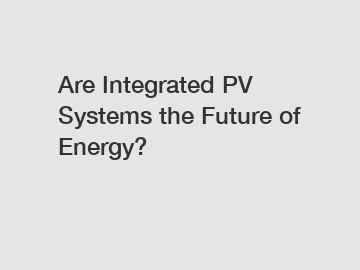Are Integrated PV Systems the Future of Energy?
Are Integrated PV Systems the Future of Energy?
Integrated PV systems, which combine solar panels with building materials such as roofs and facades, have been gaining popularity in recent years. These systems are not only capable of generating electricity but also serve as functional components of buildings. As the global demand for renewable energy continues to rise, integrated PV systems are becoming increasingly important in the transition towards a more sustainable energy future.
One of the main reasons why integrated PV systems are considered the future of energy is their versatility and efficiency. By integrating solar panels into building materials, such as glass or shingles, these systems can generate electricity while serving a dual purpose. This means that buildings can generate their own electricity, reducing their reliance on the grid and lowering overall energy costs. Additionally, integrated PV systems can be aesthetically pleasing and seamlessly blend into the design of a building, making them a more attractive option for architects and homeowners.

Furthermore, the cost of PV technology has been steadily decreasing over the past decade, making integrated PV systems more affordable and accessible. As a result, more and more buildings are incorporating these systems into their design, further driving down costs and increasing their adoption. In fact, some countries have already mandated the use of integrated PV systems in new construction projects, signaling a shift towards a more sustainable and energy-efficient built environment.
In terms of environmental impact, integrated PV systems have significant benefits. By generating clean and renewable energy on-site, these systems reduce the need for fossil fuels and lower greenhouse gas emissions. This can help combat climate change and contribute to a more sustainable energy future. Additionally, integrated PV systems can help buildings achieve higher levels of energy efficiency and reduce their overall carbon footprint.
Overall, integrated PV systems are indeed the future of energy. Their versatility, efficiency, affordability, and environmental benefits make them a key component in the transition towards a more sustainable energy future. As technology continues to improve and costs continue to decrease, we can expect to see more and more buildings integrating PV systems into their design. This trend not only has the potential to revolutionize the way we generate and consume energy but also has far-reaching implications for our environment and society as a whole.
Are you interested in learning more about solar roof tiles sydney, bipv product, bipv solutions? Contact us today to secure an expert consultation!
126
0
0


Comments
All Comments (0)